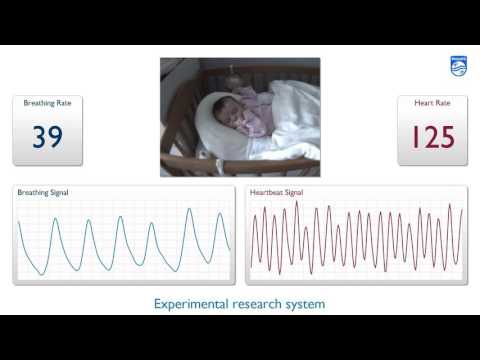
Ask how many new parents stay up watching their baby’s chest rise and fall and you’ll find out its a pretty common occurrence among newbies.
Instead of staying up to watch and missing out on much-needed sleep, what if a camera could take over for you. Or what if your NICU baby didn’t have to be covered in wires and sensors to check on his or her vitals?
Recently it was demonstrated that absolute oxygen saturation of arterial blood (SpO2), a vital sign that is commonly monitored in hospitalized patients, can be accurately measured across multiple patients with a contactless technology.

Learning this, Philips decided it would develop a product that could be implemented into the home.
Philips proprietary camera-based monitoring technology measures the light reflected off people’s foreheads to calculate SpO2. The company’s contactless SpO2 can be calibrated across patients, just like conventional contact probes, allowing accurate measurements without individual adjustments.
Checking heart rate, arterial blood oxygenation, respiration rate, and activity is a standard part of patient care in hospitals or in-home health care. The current method for measuring these key vital signs requires the use of sensors on the skin or devices strapped to the body.
When it comes to babies, contact sensors can cause damage and distress, especially with such fragile skin
“Vital signs monitoring is crucial across all types of care settings, but for patient populations with specific conditions, managing their care in a less intrusive way is critical in order to avoid unnecessary distress,” said Carla Kriwet, CEO of Philips Patient Care & Monitoring Solutions. “Contactless monitoring solutions will offer clinicians with a way to accurately measure vital signs for patients in a non-obtrusive way, and provide them with the data needed to know when to intervene.”
For specific patient populations, including premature infants in the NICU, a contactless alternative would provide advantages such as avoiding skin damage and freedom to select a more physiologically central location with a possible faster response rate. With every heartbeat, the cardiovascular pressure wave causes tiny changes in skin color on the face. While these changes are not visible to the human eye, Philips’ monitoring algorithms can calculate an accurate pulse rate by quantifying these changes.
According to the company, this is the first study that has been able to demonstrate that calibrated contactless monitoring of absolute blood oxygen levels is possible. In this recent study, calibration of contactless, camera-based pulse oximetry was performed on a population of 41 healthy adults and the results are promising for the successful use of contactless monitoring for absolute blood oxygen levels in care settings without individual adjustments.
For more details on the full study, visit the website.

Comments are closed, but trackbacks and pingbacks are open.